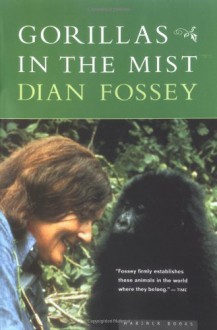
Much like when I reviewed Jane Goodall's In the Shadow of Man, I quickly fell in love with the gorillas that Dian Fossey describes in exquisite detail in her book Gorillas in the Mist. (You may have heard of it.) Dr. Fossey moved to the Virungas of Africa (Zaire, Uganda, and Rwanda) to study the mountain gorillas that lived there. That study ended up taking nearly 20 years. However, she wasn't only studying the habits of the gorillas but also the parasites, environment (rainfall), vegetation, and the other animals that lived there (elephants, buffalo, duiker). (Basically, whatever she and her team could study they did to increase their chances of getting more grant money and lengthening their stay.) One of the things that Fossey stressed was that it would take more than passive conservation (tourism) to keep the mountain gorillas alive and thriving. She found that active conservation was the only way to go which meant that she had to employ staff to track down poacher's lairs and destroy their supplies and traps. Basically, she was a bada$$ of the highest caliber and the surrounding villagers had a nickname for her (it wasn't sweet lady of the mountain either). She quickly earned a reputation for not backing down and for doing everything within her power to protect these creatures from imminent extinction (which is looking more and more likely). Between poachers, population encroachment, and decreasing territory for the different gorilla groups there were only 242 mountain gorillas left at the end of her nearly two decade study. There are even less now. Fossey's fervent desire was that governments and the people governed by them would want to conserve these animals because they lived in the area providing the only fresh water source for the region. However, deforestation to make way for increasing numbers of people and farms continued no matter what arguments she put forth. I had heard about this book and its movie adaptation before but it wasn't until I saw Ellen DeGeneres talking about it (on her birthday episode) that I decided to finally pick up the book. I am so glad that I did. Even if you only read the appendices (which are absolutely phenomenal) you'd learn so much about these amazing animals and the land they inhabit. You'd also bear witness to the dedication and passion which Fossey had for her research. I highly recommend you pick up a copy of Gorillas in the Mist and afterward that you do further research into Fossey because it makes it all the more poignant and meaningful (at least it did for me). 10/10
What I'm Currently Reading: juggling 3 books as the mood strikes me.

 Log in with Facebook
Log in with Facebook 






